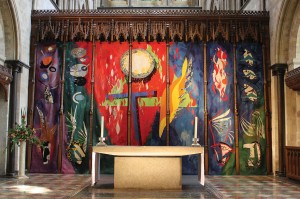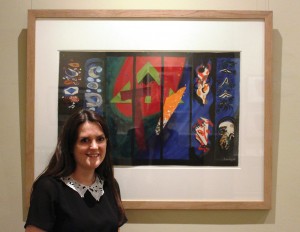
Picasso, Matisse, Braque and other celebrated, international artists all worked in collage. The word collage comes from the French verb coller, to stick or glue. The technique was used by both cubists and surrealists. British artists like John Piper, Nigel Henderson and Eduardo Paolozzi all embraced this method of working.
The current exhibition Modern British Collage and its Legacy at Pallant House Gallery, Chichester, seeks to explore the role of collage in the course of modern British art. Exhibition curator Katy Norris comments, “Collage evolves in the 20th century from a marginal process to become a central part of the modern aesthetic.” She continues, “It is extraordinary how surrealists, pop and conceptual artists all embrace this method of working.” The works in this captivating exhibition are from the Gallery’s own remarkable collection. The pictures by Ben Nicholson, John Piper, William Scott, Ceri Richards, Nigel Henderson and, of course, Eduardo Paolozzi clearly articulate the importance of collage in British modernism.
I am particularly drawn to a preliminary collage design by John Piper for the reredos tapestry at Chichester Cathedral. In his book Patron of Art, Walter Hussey, then Dean of Chichester Cathedral and famous for his patronage of the arts, notes how he chose to follow Henry Moore’s advice to commission John Piper to create a worthy setting for the High Altar. Piper, known for his atmospheric depictions of English architecture and landscape, returned to the abstraction of his earlier work for this commission. A distinguished artist with a great sympathy for old churches, he suggested a tapestry. Tapestry, he argued, would work in concert with the old stonework and the 16th century carved oak screen. He felt that the seven strips of tapestry would be able to be read as a whole across the narrow wooden buttresses of the screen with its crest of medieval canopies. The original plan was to gild and paint these medieval sections but John Piper advised that they should be left plain and his advice was accepted. In January of 1965 Piper presented a final sketch, which met with favourable opinion. At lunch with Hussey and others, however, Piper was deeply troubled when the Archdeacon of Chichester commented that there was no specific symbol for God the Father in the central section of the design. The lack of this symbol in the earlier collage by John Piper, shown here with Katy Norris, is notable. Katy explains, “In this preliminary design we see the early scheme, worked out using simple cut-out shapes, which enabled Piper to trial different pictorial arrangements.” After much consideration, Piper introduced the white light left of centre on the tapestry itself, shown here in situ. The tapestry panels are schematic in their use of symbolism. The Trinity is represented in the three central panels. God the Father is depicted by a white light, God the Son by the blue Tau Cross and the Holy Spirit as a flame-like wing, all united by a red equilateral triangle within a border of green scattered flames. The flanking panels depict the Gospel Evangelists, Saint Matthew (a winged man), Saint Mark (a winged lion), Saint Luke (a winged ox) and Saint John (a winged eagle), beneath the Four Elements, earth, air, fire and water. Woven by the Pinton Frères atelier at Felletin, near Aubusson, the tapestry was installed in the autumn of 1966.
Whether we immediately understand the symbolism of the tapestry or not, it speaks to our senses and we cannot fail to be moved on many levels. The work’s length, structure, tone, rhythm and colour have a lyrical quality, which tells of our creator God in His Trinity.

Before seeing the current series of exhibitions at Pallant House Gallery, I had not fully appreciated the importance of collage to artists like John Piper. Katy Norris concludes, “The link between the preliminary collage and the tapestry at Chichester Cathedral emphasizes that an important international artist like John Piper was working in Chichester at the Cathedral, thanks to the patronage and insight of Walter Hussey.”
I am excited that Toovey’s Fine Art Auctioneers are sponsoring Modern British Collage and its Legacy at Pallant House Gallery. The exhibition runs until 29th September 2013. While you are there, you must make sure that you also see Eduardo Paolozzi: Collaging Culture and perhaps wander over to Chichester Cathedral and allow the Piper tapestry to move you and delight your senses. It is a wonderful thing to reflect upon as you listen to and join with sung evensong – the modern and the ancient united.
For more information and opening times, go to www.pallant.org.uk and www.chichestercathedral.org.uk
Image1: John Piper’s Chichester Cathedral reredos tapestry, circa 1966, depicting the Trinity, the Evangelists and the Elements.
Image2: Katy Norris, Pallant House Curatorial Assistant and Exhibition Curator for Modern British Collage and its Legacy, with John Piper’s preliminary collage design for the Chichester Cathedral tapestry, circa 1965.
By Revd. Rupert Toovey. Originally published on 28th August 2013 in the West Sussex Gazette.